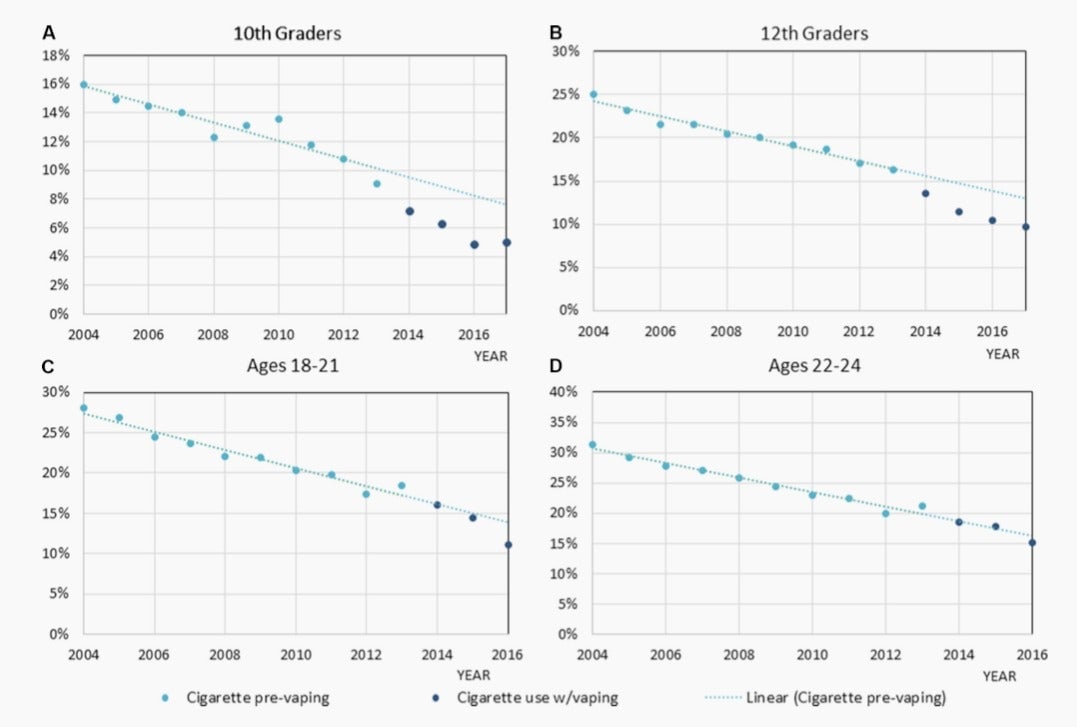That big claim that vaping leads to smoking may be based on insubstantial evidence
For the past few months, the US Food and Drug Administration (FDA) has been waging a battle on e-cigarettes.


For the past few months, the US Food and Drug Administration (FDA) has been waging a battle on e-cigarettes.
In September, the FDA gave e-cigarette companies 60 days to figure out how to prevent teenagers from vaping. When that period ended last week, the organization ruled that vape companies could still sell e-cigarette cartridges in retail stores, provided that the devices were in an area only accessible by those 18 and older.
E-cigarettes have been around since 2003 (pdf, p. 10), and in the US since 2007, but only became popular with US teenagers around 2011, according to data from the US Centers for Disease Control and Prevention (CDC). Since then, teen vaping has exploded: last year, the number of teenagers under 18 who reported smoking e-cigarettes doubled compared to the previous year, reaching almost 20%. And major scientific bodies ranging from the CDC to National Academies of Science, Engineering, and Medicine (NASEM), have argued (pdf) that e-cigarettes are a gateway for teenager and young adults to start smoking tobacco-filled cigarettes.
There’s just one problem: trends over time don’t indicate that this is true.
On Tuesday (Nov. 20) researchers from the US, Canada, and Australia published a new review in the journal Tobacco Control showing that major surveys conducted between 2004 and 2017 do not indicate that vaping among US teens does not lead to smoking. After e-cigarettes hit the US market, cigarette smoking rates among teenagers and young adults continued to fall at more or less the same rate (paywall) as they had before. Further, when vaping became especially popular with teens, around 2014, the decline in teen cigarette-smoking rates sped up.
“If our primary concern is population-level trends in youth and young adult smoking, which we believe is appropriate, then vaping has not shown to be a serious cause for concern,” the authors write. “It is possible that vaping may be playing a contributing role to the recent steep declines in youth and young adult smoking.”
The research team reviewed five major surveys distributed among teenagers and adults under 26: the Monitoring the Future Survey, the National Youth Tobacco Survey, the Youth Risk Behavior Survey, the National Survey of Drug Use and Health, and the National Health Interview Survey. Each of these surveys used different questions and metrics, but enabled the team to identify a general trend: 2014 was the year vaping took off, and in the years that followed, cigarette-smoking rates decreased more than expected.

This doesn’t necessarily mean the rise in vaping is causally related to a decrease in cigarette smoking. In the years since 2014, the FDA issued stricter regulations on tobacco, as well as media campaigns which may have deterred teenagers from picking up cigarette smoking. However, the authors note that the idea that some teenagers were switching from cigarettes to e-cigarettes is a “plausible explanation” for the trends.
That suggests a dynamic that contradicts concerns raised previously by a number of health organizations, such as the claim made by the NESM in a 2018 report (pdf) that “there is substantial evidence that e-cigarette use increases risk of ever using combustible tobacco cigarettes among youth and young adults.”
That said, all of these surveys are only asking periodic questions about use; some teens who try vaping may still switch over to cigarettes later in life. In any case, the good news, the authors of the new study say, is that it doesn’t appear to be the case that the overall decrease in tobacco use among teens will slow down on account of vaping.
Correction (Nov. 20): An earlier version of this story stated the research was published in the British Medical Journal. It was published in Tobacco Control, a specialist journal of the BMJ.